A Non-Disclosure Agreement (NDA), popularly referred to as a “Confidentiality Agreement,” is a legal agreement that binds the Recipient of confidential Information from disclosing it to unauthorized parties. The Party or Parties upon signing the Agreement acknowledge that they shall not disclose any Confidential or Proprietary Information they obtain from the Disclosing Party.
Free Templates by Types
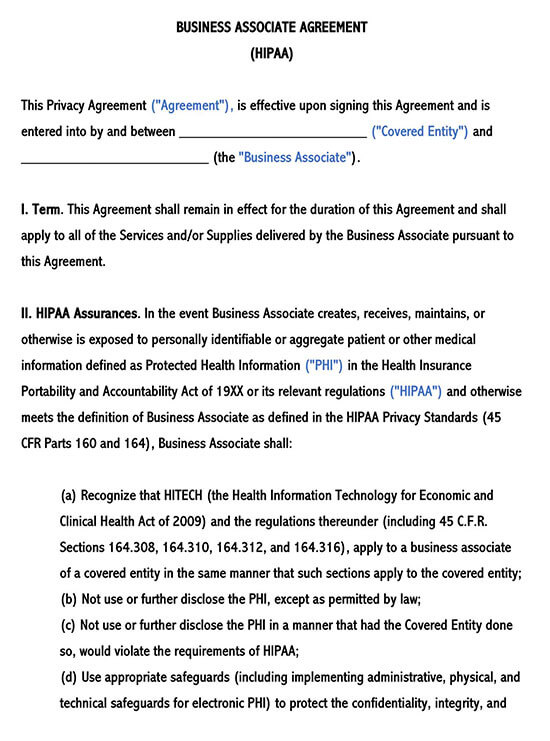



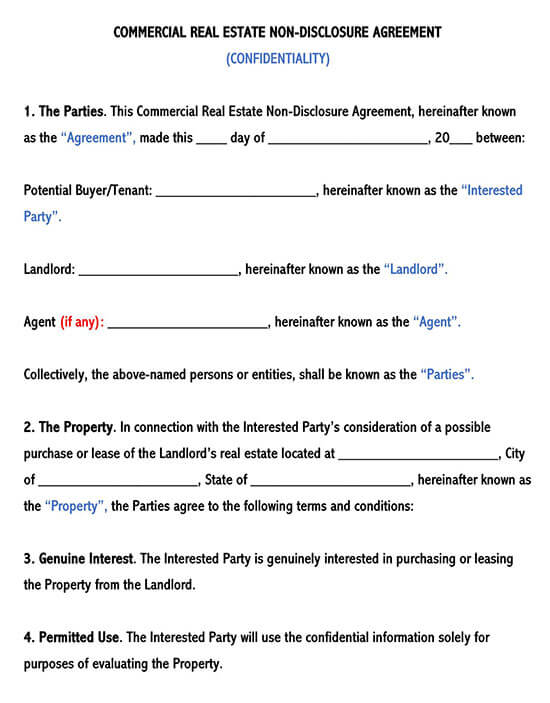
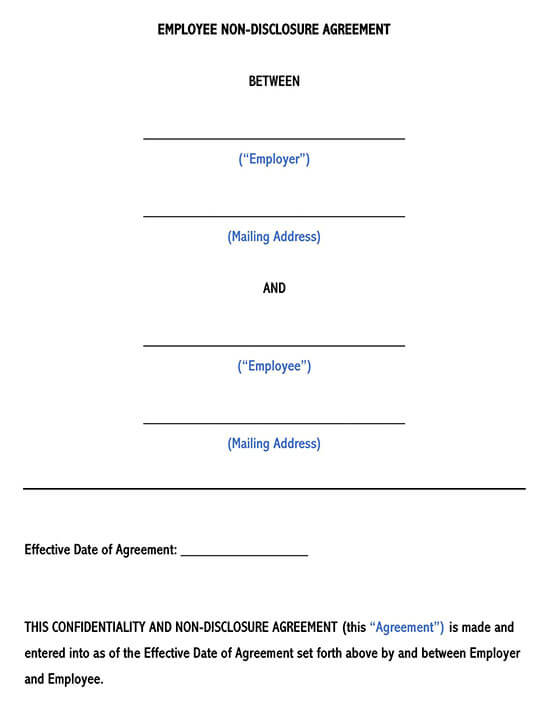



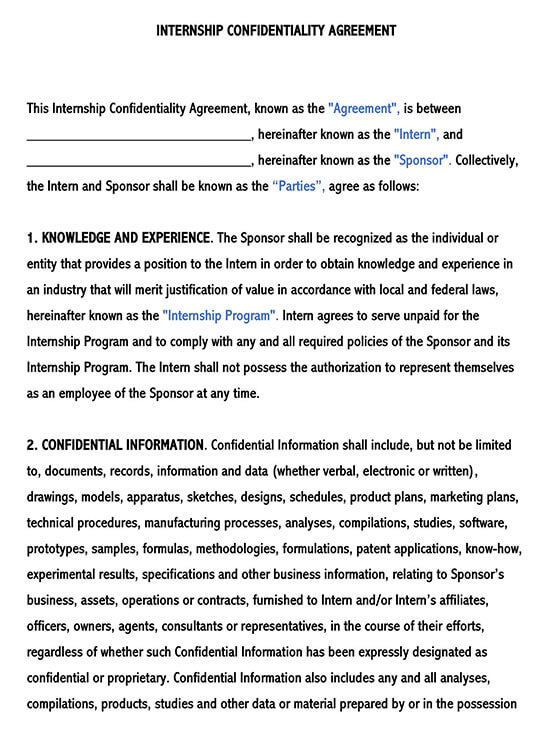
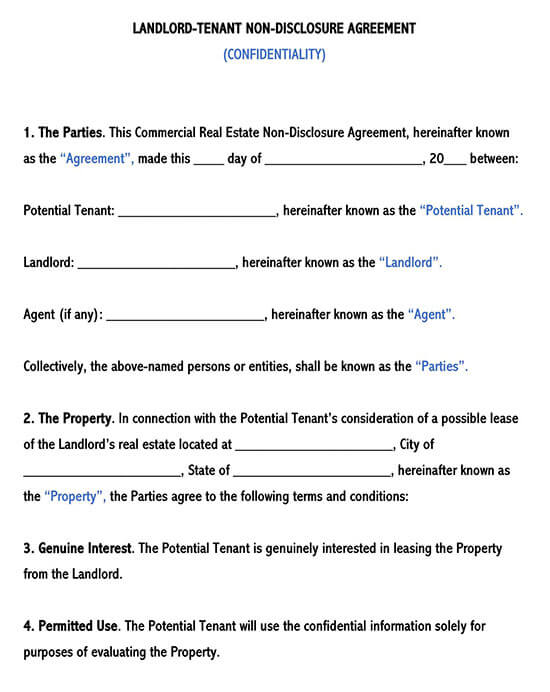

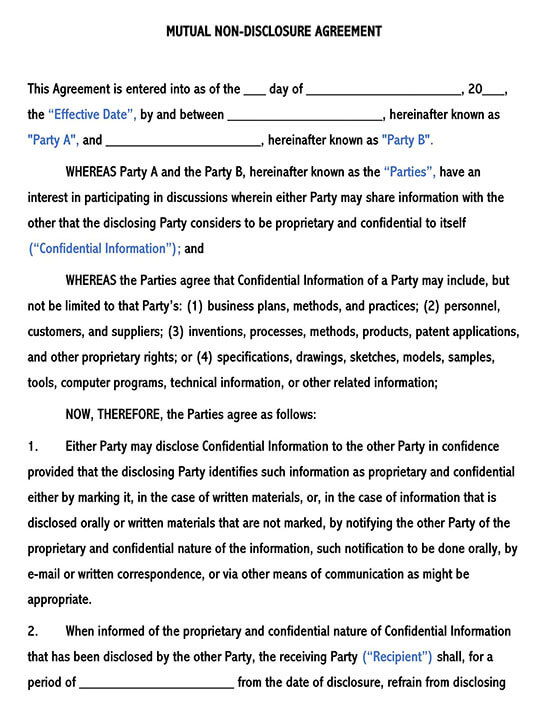
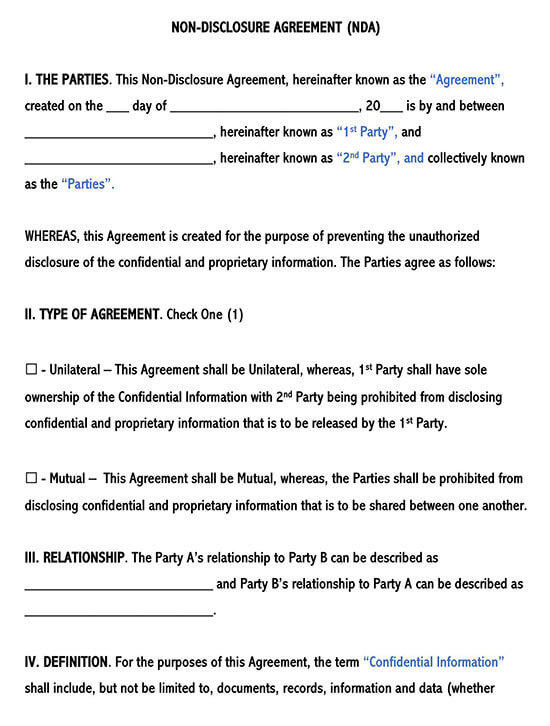

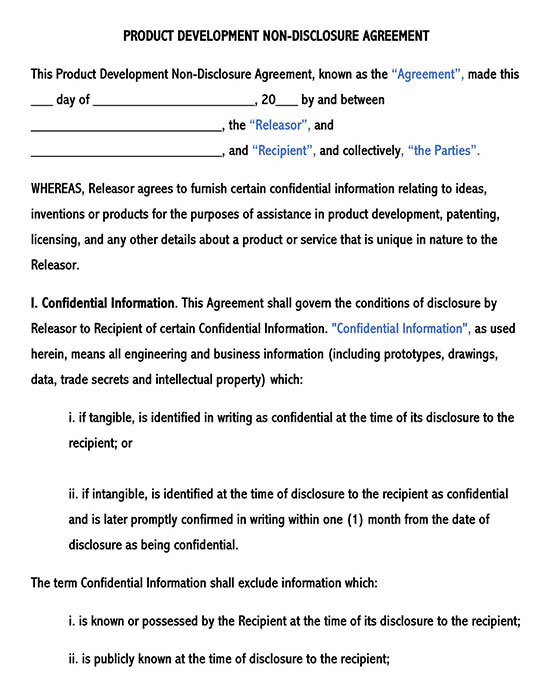


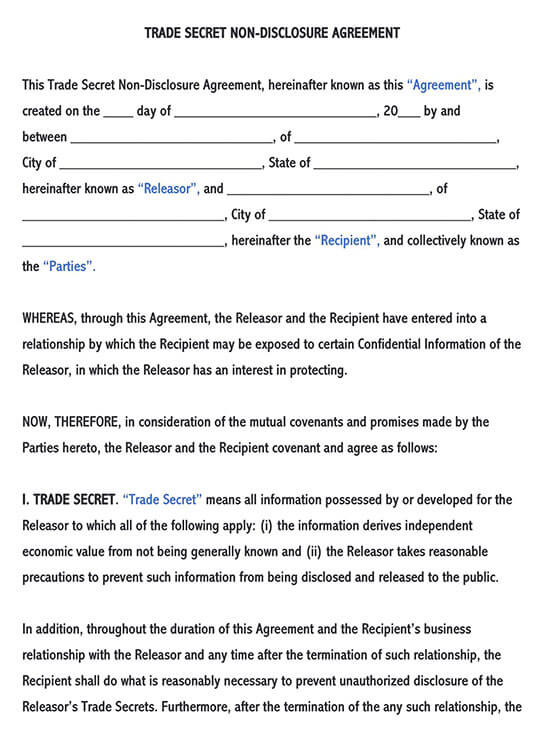



Categories of NDAs
Generally, there are three main categories of NDAs:
- Unilateral NDA:Two parties are involved in this type of NDA. Only one party discloses Confidential Information, and the other party is bound to ensure that the information is not disclosed further without consent from the Disclosing Party.
- Bilateral NDA: Two parties are involved in this type of NDA. Whereby both parties disclose Confidential Information, they are both tasked with ensuring that the information disclosed remains confidential.
- Multilateral NDA: Generally, three or more parties are involved in this type of NDA. Of which only one party discloses Confidential Information, and the rest is to ensure that the confidentiality of the information is maintained.
Benefits of NDAs
Signing a NDA has many benefits.
Here are some of the significant benefits of an NDA:
- Since a NDA is a legal document, it is of utmost importance for any conflict that might arise in the future. Any party that breaches the Agreement is held accountable and is legally liable to compensate for any damages caused.
- It clearly defines what is to be considered as “Confidential” thereby avoiding any ambiguity or loss of information
- It ensures that any information shared between engaging parties remains confidential and reduces the chances of any critical information being disclosed to the public.
An NDA can also help in safeguarding business assets, including but not limited to:
- Processes
- Business Strategies and methods
- Designs, Blueprints, and Specifications
- Formulas
- Physical devices and Articles
- Computer Software
- Customer Lists
- Collection of data
Precautions while creating and signing a NDA
Before signing an NDA, here are a few things you need to take care of:
- Go through the document and ensure that all the information mentioned is precise and that you fully understand the Agreement.
- Make sure that the parties involved in the Agreement read the entire NDA and verbally explain it to avoid any misunderstandings.
- Avoid including non-required clauses or conflicting sentences when drafting an NDA.
General Contents of a NDA
All NDAs must have the following:
- The parties involved
- The disclosure Period
- Definition of what is confidential
- The term of the Agreement
- Any exclusions from what is to be kept confidential
- Any obligations to keep the information confidential
- Any types of acceptable disclosure, such as law enforcement
- Ending the Agreement
- Remedies in case of breach of confidentiality
Non-Disclosure Agreement Glossary
Here are some of the words you are likely to come across when drafting or signing an NDA:
- Cease and Desist: a letter from the owner of the Confidential/Proprietary Information requesting the alleged illegal activity to be stopped with immediate effect.
- Clean Room: this is a method of developing proprietary material with an isolated development team monitoring the content produced, to ensure that they can provide evidence that any similarities to other works or products are solely due to legitimate constraints and not copying.
- Common-Law: This is a system of legal rules derived from previous principles established by court decisions.
- Copyright: is a type of intellectual property that limits other parties from copying, selling or making derivative versions of creative work, usually for a limited time
- Database: a structured set of information organized in a manner to facilitate its retrieval.
- Declaratory Relief: it refers to decisions by the court, which determines the rights of the parties in the Agreement without ordering anything be done or awarding damages.
- Economic Espionage Act: this act makes it a federal crime for any person to steal, receive, possess, or trade secrets knowing that it has been stolen.
- Evaluation Agreement: this is an agreement in which one party agrees to share their idea, and the other party consents to evaluate it and, after that, not disclose or use the idea.
- Fiduciary Relationship: Also known as a confidential relationship. A fiduciary relationship is a relationship in which one party places special trust, reliance, and confidence in and is influenced by another party who must act on behalf of the party.
- Generally known: Information is usually known if it is available in the public domain or is commonly used within an industry.
- Improper Means: Acquiring trade secrets through theft, breach, bribery, or enticement to breach secrecy or espionage through electronic or other means.
- Injunction: a court order is necessitating that a party stops a particular activity or compelling them to carry out a specific act.
- Jurisdiction: the rule of a court to hear certain types of cases.
- License: official permission to do, use, or own something.
- Misappropriation: Breach of trade secrets.
- Non-Competition Agreement: this is a legal agreement between an employer and an employee whereby the employee approves not to enter into competition with the employer during or after the employment period.
- Non-Solicitation Provision: this is a contract restricting an individual/former employee from soliciting clients after the employee departs from the business.
- Patent: a grant from a government, protecting an invention from employees, contractors, or third parties from sharing or copying the concept/design.
- Trademark: a symbol, word, words, design, device, slogan, or combination legally registered or established by use as representing a company or product.
- Trade Secret: any information that is of economic value to the business that is not available in the public domain.
- Uniform Trade Secrets Act (UT SA): This is a model act, drafted by the National Conference on Uniform State Laws and has been adopted as the basis of trade secrets in over 40 states.
How to Write a NDA
Introduction paragraph
In the introduction paragraph, include the names of both the “Disclosing Party” and the Recipient of the “Confidential Information,” the “Receiving Party.” The terms are capitalized to show that they are defined in the Agreement.
EXAMPLE
This Non-Disclosure Agreement (NDA) is entered into by and between ____________ (The “Disclosing Party)_______________ (The “Receiving Party”) conjointly referred to as the “parties” in this Agreement to prevent the unauthorized disclosure of information as defined below.
Definition of confidential information
In this paragraph, define what is to be considered confidential or proprietary information without actually disclosing the actual information. For instance, “A software that helps you analyze financial data.” You must also ensure that any information not designated as confidential is clearly defined.
EXAMPLE
For this Agreement, “Confidential or Proprietary Information” shall refer to any information that the Disclosing Party shall provide to the Receiving Party, be it technical or non-technical. The information, whether in writing or any other form, shall be considered confidential in this Agreement. If the information provided is in written form, then the Disclosing Party shall label or stamp the material with the word “CONFIDENTIAL” or any other similar warning. If the information is conveyed orally, the Disclosing Party shall indicate in writing that such oral communications constituted Confidential Information.
Exclusions from confidential information
This paragraph describes all the information not covered in the Agreement.
The Receiving Party shall not be held accountable for disclosing any information that is already known to the public.
Obligations of receiving party
This clause states what is required of the Receiving Party upon signing the “Agreement.”
EXAMPLE
“The Receiving Party shall at all times uphold and maintain the Confidential Information of the other Party in utmost confidence for the ultimate and exclusive benefit of the “Disclosing Party.”
Duration of agreement
This clause defines the period to which the Agreement should last. It can either be infinite or definite, depending on the type of information covered in the Agreement.
Example of Infinite Period Clause
EXAMPLE
The Receiving Party shall be bound to keeping the “Confidential Information” as such until such a time when the Confidential Information no longer qualifies as a trade secret or until the Disclosing Party sends, in writing, a notice to the Receiving Party relieving them of their duties and responsibilities from this Agreement.
Example of Fixed Period Clause
EXAMPLE
The Receiving Party shall uphold the Confidentiality of the Information provided by the Disclosing Party, and this Agreement shall remain in effect until ______________
Relationships
This clause is meant to dissociate from any other relationships that are not the intent of the Agreement.
EXAMPLE
This Agreement shall not be considered to institute either party a partner, Joint venture, or employee of the other party for any purpose of any kind.
Severability
This clause provides that, in the event of a legal battle over the Agreement and it is ruled by the court that a section of the Agreement is void, that part can be ruled out. The rest of the Agreement remains valid.
Integration
This clause acknowledges that the version Agreement you are signing is the final version and that all other statements made in the past are void.
Waiver
This clause provides that any terms and conditions of this Agreement shall only be waived or amended upon written consent from the Disclosing Party.
Types of NDA’s
There are various types of NDAs, including:
- Business Associate (HIPAA) Agreement: Provides sample language and provisions necessary for compliance with the HIPAA rules and regulations and the HITECH Act, which covers the Relationship between a HIPAA-covered entity and a business associate.
- Business Plan Non-Disclosure Agreement: This Agreement is used when sharing a business plan with investors, consultants, contractors, potential employees, and anyone else assessing your planned enterprise.
- Business Sale Non-Disclosure Agreement: allows a seller to privately disclose all confidential information regarding sales, customers, and financial details to a potential buyer.
- Commercial Real Estate Non-Disclosure Agreement: is meant for use when the owner of a commercial real estate wants to disclose Confidential Information about a property to prospective buyers, consultants, tenants, business partners, or investors.
- Customer List Non-Disclosure Agreement: is intended for use by companies that want to sell or license their customer lists to other businesses.
- Employee Non-Disclosure Agreement: limit employees from sharing any confidential or proprietary information without permission
- Film (Movie) Non-Disclosure Agreement: meant for use when sharing original film concept, storyline or screenplay
- Financial Information Non-Disclosure Agreement: often used when disclosing financial information in contemplation of a business acquisition, an audit, or an account analysis.
- HIPAA (Employee) Non-Disclosure Agreement: used to ensure that an employee of healthcare facilities to agree not to disclose any medical information without permission.
- Independent Contactor Non-Disclosure Agreement: intended for use with workers/contractors who perform tasks for you or your business.
- Intern Non-Disclosure Agreement: meant to protect interns from disclosing any Confidential Information during Internships.
- Landlord-Tenant Confidentiality Agreement: is meant for use when the landlord is disclosing any Confidential Information about a property to a potential tenant.
- Mutual Non-Disclosure Agreement: is meant to create a Confidential Relationship between two parties engaging in exchange of Confidential Information.
- Patent/Inventory Non-Disclosure Agreement: intended for use when protecting an invention from employees, contractors, or third parties from sharing or copying the concept/design.
- Product Development Non-Disclosure Agreement : This Agreement is used to protect the Releaser’s Intellectual Property before patenting.
- Real Estate Buyer Confidentiality Agreement: This Agreement is for use when a seller of a property is looking to disclose Confidential Information to the potential buyer and wouldn’t want such information to be made public.
- Software Development Non-Disclosure Agreement: This Agreement intended for use when sharing information with another Party to create patentable software.
- Trade Secret Non-Disclosure Agreement: is intended for use when disclosing any proprietary information that is to be kept confidential.
- Unilateral Non-Disclosure Agreement: a standard form in which only one party shall be responsible for maintaining the confidentiality of the information provided.
- Violation of Non-Disclosure Agreement: also referred to as a Cease and Desist Order. This Agreement is meant to warn the Receiving Party of Confidential Information that if they do not stop violating the information, legal actions shall be taken against them.
- Volunteer Non-Disclosing Agreement: This Agreement is intended for use when any guests are agreeing to provide their time and labor for free with the condition of upholding any information shown to them with utmost confidence.
- Website Design Non-Disclosure Agreement: This Agreement is intended for use when protecting confidential and proprietary information against any third-party competitors during the development of a website.
Templates by State
Frequently Asked Questions
The other party is not lawfully obliged to keep any information provided to them before entering an Agreement a secret. However, you may decide to ask them not to disclose the information you have disclosed to them.
No. You may not amend an NDA. Once both parties to an agreement have acknowledged the Agreement, then your only option is to renegotiate with them before making any changes. You may request the other parties to maintain or renew the Agreement if an NDA expires.












